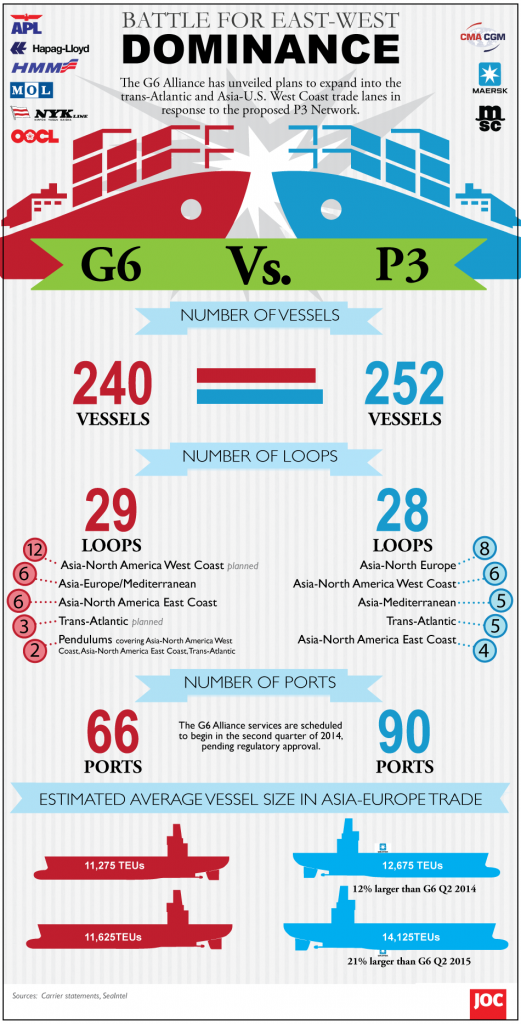The announcement of the P3 shipping network shook the ocean shipping industry, causing a ripple of effects for carriers and shippers alike. The P3 network is comprised of the largest container carriers by capacity (Maersk Line, MSC, and CMA CGM) to share vessels and capacity. The move worries shippers because the three lines accounted for a combined 37% of global container capacity in 2013.
As a result, the G6 alliance plans to expand coverage. According to PIERS, the G6 alliance was responsible for 27.1% of U.S. containerized export trade and 28.6% of U.S. containerized import trade in the first nine months of 2013.
The wave of new alliances began after Maersk Line’s launch of a seven-days-per-week “conveyor belt” service between key Asian and north European ports in 2013 as part of the carrier’s bid to create a solid cargo base for twenty 18,000 TEU ships deploying in 2014-2015.
What are the major ocean carrier alliances and who do they consist of?
- P3: Maersk, Mediterranean Shipping Co., and CMA CGM.
- G6: Hapag-Lloyd, NYK, OOCL, Hyundai Merchant Marine, APL, and MOL.
- CKYH (a.k.a “Green Alliance”): Cosco, Kline, Yang Ming, and Hanjin in close cooperation with Evergreen.
Why is the P3 shipping alliance different?
- The vessels of the P3 network will be operated independently by a joint vessel operating center in London.
- The ships are significantly larger, younger, and more fuel efficient than its peers.
What major changes have ensued as a result?
- The G6 alliance is planning to expand the alliance’s coverage into the trans-Atlantic and Asia-U.S. West Coast trade lanes and will deploy 240 container ships serving 66 ports in Asia, America and Europe. The JOC reports that the” G6 plans to deploy 42 ships on five trans-Atlantic services, including two pendulum services calling at 25 ports in the U.S., Canada, Panama, Mexico, the Netherlands, the U.K., France, Belgium and Germany. The member carriers will continue to market their services individually.”
- Hapag-Lloyda and Compania Sud Americana de Vapores have signed a nonbinding memorandum of understanding to merge their sea transport businesses. The WSJ reports that “If successful, the merger will create the world’s fourth-largest container shipper in terms of capacity, with annual revenue of around $13 billion. The two companies began talks in December. People involved in the deal said the German company will control around 70% of the merged entity, with CSAV owning the remainder.”
- Hanjin Shipping Co. will close two loss-making container shipping lines within the first half of the year.
- Although not an official alliance, Evergreen has agreed to work in close collaboration with the CKYH alliance. According to the “green alliance,” “Although Evergreen will not be joining CKYH, the carriers will co-ordinate with each other to provide more intensive sailings to the level of eight service loops from Asian ports to northern European base ports, and four service loops from Asian ports to Mediterranean ports every week.”
When will shippers feel the changes?
According to London-based consultant and research analyst Drewry , “Due to lackluster cargo growth and unexciting prospects ahead, little change to ocean carrier services is likely before the second quarter of 2014.” But according to the JOC, “all bets are off in the spring when the world’s leading carriers prepare to inject a little long overdue excitement on the Atlantic.”


